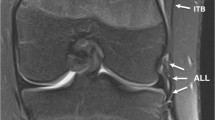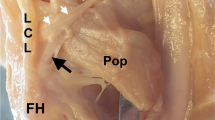Abstract
Background
Meniscofemoral ligaments (MFLs) are recognized as stabilizing and protective structures for the posterolateral meniscocondylar compartment of the knee, and as secondary restraints to tibial posterior translation.
Purpose and patients
We report the 64-row arthro-MDCT findings of 10 patients (8 males, 2 females; mean age 43.8 years) in which the anterior MFL of Humphrey (aMLF) was atypically well delineated by an unusual circumferential effusion of iodine contrast. We discuss a possible physiopathologic mechanism for this effusion, describe the MDCT anatomy of the aMLF and review the literature about the anatomy and physiology of the MFLs.
Results
In each of our ten patients an unusual effusion of articular contrast was found delineating a posterior oblique ligamentar bundle, which was running in front of the posterior cruciate ligament (PCL). This bundle was best appreciated on posterior coronal oblique and sagital MPR views, and was recognized as the aMFL. The finding was associated with a partial tear of the tibial insertion of the posterior horn (PH) of the lateral meniscus (LM) in three patients, and with a partial (two cases) or subtotal (three cases) tear of the PCL in five patients. A swollen—probably oedematous—PCL was found in another patient and in the last case the anomaly was minimal and remained isolated. All patients were treated conservatively.
Conclusion
Since the aMFL inserts inferiorly into the posterior horn of the LM and runs in very close anatomic and functional relation with the PCL, we hypothesize that a trauma producing a tear in these structures may also occasionally sufficiently stretch the aMFL to produce a peripheral loosening allowing a circumferential effusion of opacified synovial fluid around the ligament. Our report offers the opportunity to illustrate the “in vivo” anatomy of the aMFL through original unpublished figures. It also contributes to reinforce the literature data concerning the potential fine mechanical role played by the LM–MFLs–PCL complex, in which the centrally located MFLs act laterally as stabilizing and protective structures for the posterolateral meniscocondylar compartment and medially as secondary restraints to tibial posterior translation.






Similar content being viewed by others
References
Amis AA, Bull AM, Gupte CM et al (2003) Biomechanics of the PCL and related structures: posterolateral, posteromedial and meniscofemoral ligaments. Knee Surg Sports Traumatol Arthrosc 11:271–281
Amis AA, Gupte CM, Bull AM, Edwards A (2006) Anatomy of the posterior cruciate ligament and the meniscofemoral ligaments. Knee Surg Sports Traumatol Arthrosc 14:257–263
Cho JM, Suh JS, Na JB et al (1999) Variations in meniscofemoral ligaments at anatomical study and MR imaging. Skeletal Radiol 28:189–195
Clancy WG, Shelbourne KD, Zoellner GB et al (1983) Treatment of knee joint instability secondary to rupture of the posterior cruciate ligament. Report of a new procedure. J Bone Joint Surg Am 65:310–322
Coulier B, Devyver B, Hamels J (2002) Imaging demonstration of fistulous gas communication between joint and ganglion of medial malleolus. Skeletal Radiol 31:57–60
Coulier B, Cloots V (2003) Atypical retroperitoneal extension of iliopsoas bursitis. Skeletal Radiol 32:298–301
Coulier B (2006) Direct 3D imaging of the knee menisci during 16-row multislice CT arthrography. JBR-BTR 89:291–297
de Abreu MR, Chung CB, Trudell D, Resnick D (2007) Meniscofemoral ligaments: patterns of tears and pseudotears of the menisci using cadaveric and clinical material. Skeletal Radiol 36:729–735
Gupte CM, Smith A, McDernott ID et al (2002) Meniscofemoral ligaments revisited. Anatomical study, age correlation and clinical implications. J Bone Joint Surg Br 84:846–851
Gupte CM, Bull AM, Thomas RD, Amis AA (2003) A review of the function and biomechanics of the meniscofemoral ligaments. Arthroscopy 19:161–171
Gupte CM, Bull AM, Murray R, Amis AA (2007) Comparative anatomy of the meniscofemoral ligament in humans and some domestic mammals. Anat Histol Embryol 36:47–52
Harner CD, Xerogeanes JW, Livesay GA et al (1995) The human posterior cruciate ligament complex: an interdisciplinary study. Ligament morphology and biomechanical evaluation. Am J Sport Med 23:736–745
Kusayama T, Harner CD, Carlin CJ, Xerogeanes JW, Smith BA (1994) Anatomical and biomechanical characteristics of human meniscofemoral ligaments. Knee Surg Sport Traumatol Arthrosc 2:234–237
Lee BY, Jee WH, Kim JM, Kim BS, Choi KH (2000) Incidence and significance of demonstrating the meniscofemoral ligament on MRI. Br J Radiol 73:271–274
Miller MD (1994) Posterior cruciate ligament injuries: history, examination and diagnostic testing. Sport Med Arthrosc Rev 2:100–105
Moran CJ, Poynton AR, Moran R, Brien MO (2006) Analysis of meniscofemoral ligament tension during knee motion. Arthroscopy 22:362–366
Ranaletta M, Rossi W, Paterno M, Brigatti NA, Ranaletta A (2007) Incidence of the anterior meniscofemoral ligament: an arthroscopic study in anterior cruciate ligament-deficient knees. Arthroscopy 23:275–277
Sonin A, Reister JA (2003) Intra-articular ganglion arising from the meniscofemoral ligament of Humphrey. Skeletal Radiol 32:295–297
Vande Berg BC, Lecouvet FE, Poilvache P et al (2000) Dual-dectector spiral CT arthrography of the knee: accuracy for detection of meniscal abnormalities and unstable meniscal tears. Radiology 216:851–857
Vande Berg BC, Lecouvet FE, Poilvache P, Maldague B, Malghem J (2002) Spiral CT arthrography of the knee: technique and value in the assessment of internal derangement of the knee. Eur Radiol 12:1800–1810
Vande Berg BC, Lecouvet FE, Poilvache P et al (2002) Anterior cruciate ligament tears and associated meniscal lesions: assessment at dual-dectector spiral CT arthrography. Radiology 223:403–409
Watanabe Y, Moriya H, Takahashi K et al (1993) Functional anatomy of the posterolateral structures of the knee. Arthroscopy 9:57–62
Author information
Authors and Affiliations
Corresponding author
Rights and permissions
About this article
Cite this article
Coulier, B. Signification of the unusual delineation of the anterior meniscofemoral ligament of Humphrey during knee arthro-CT. Surg Radiol Anat 31, 121–128 (2009). https://doi.org/10.1007/s00276-008-0416-4
Received:
Accepted:
Published:
Issue Date:
DOI: https://doi.org/10.1007/s00276-008-0416-4




